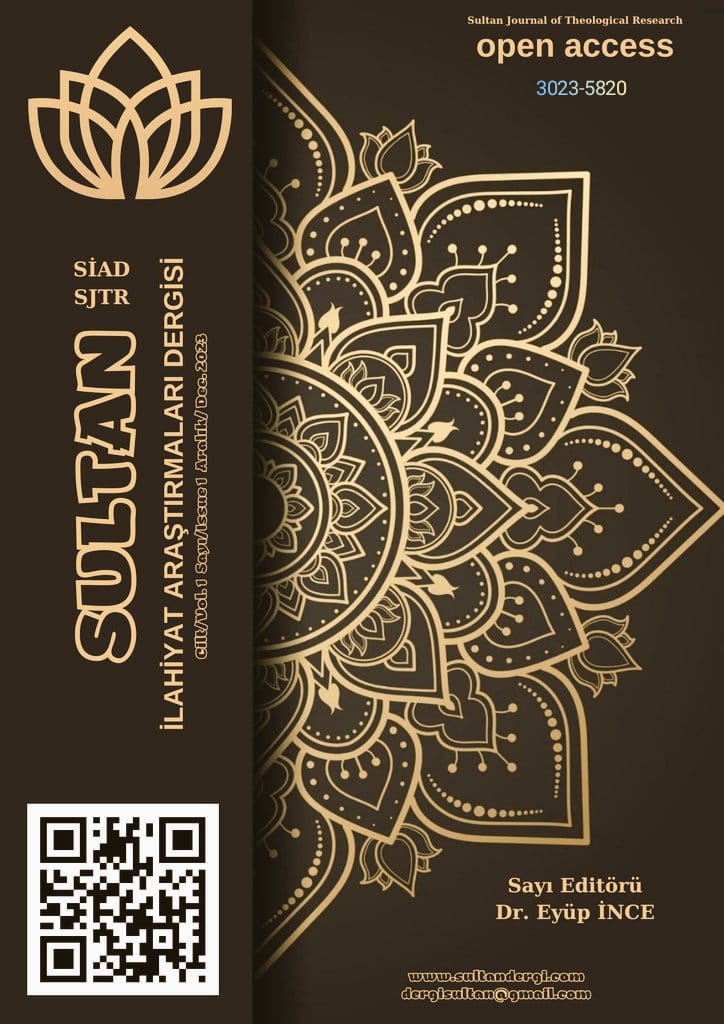Analysis of Symbolic Expressions About Humans in the Quran
DOI:
https://doi.org/10.5281/zenodo.10443449Keywords:
Keywords: Tafsir, Language, Human, Symbolism, Revelation, Parable.Abstract
Every theologian has his own unique language and style of expression. Since Almighty Allah is a deity, he has ontologically different qualities from other theologians. Therefore, communicating with people who have an ontological difference between them and being able to appeal to their perception requires a certain level of communication. At the same time, this form of communication can bring about problems of understanding. Although the revelations revealed by Almighty Allah to humans are generally clear and easily understandable in terms of language, a significant part of them are symbolic and contain aspects that tire human understanding and make it difficult to understand. From a wholesale perspective, accepting all of these divine statements as symbolic expressions and taking an approach that focuses only on symbolic meanings, or considering all of them as literal expressions and evaluating them only in terms of their literal meanings, leads to some problems of understanding and interpretation. Because evaluating these expressions based on a uniform approach destroys the richness of their meaning and prevents the correct understanding of the message intended to be given. Correct understanding and interpretation of expressions is only possible if they are approached with correct understanding and interpretation techniques. At this point, it would be appropriate to benefit from concretization techniques used to make the abstract in language understandable. In understanding the symbolic expressions of the Quran about humans, relying only on the structural (sarf) and syntax (nahiv) rules of the Arabic language is insufficient. Therefore, in this study, we aimed to analyze the symbolic expressions in the Quran that talk about humans, based on analysis methods that do not neglect the linguistic rules we mentioned, but go beyond them. During our research, we found that the majority of commentators interpreted these expressions with the same method, and we took their attitudes as our guide. This research, in which we aim to reveal an important aspect of the human imagination in the Quran, is very important in terms of revealing a method that enables the correct understanding and interpretation of the verses containing symbolic expressions. In this research, in which we first drew the framework of the concept of Symbolism and then analyzed the symbolic expressions within and outside the Qur'anic stories by determining the ones related to humans, understanding the verses containing symbolic expressions with their real meaning will lead us to erroneous inferences, and instead, we try to determine the meanings represented by the symbols they contain in these verses. We came to the conclusion that interpretation like this is the most reliable way.
Highligts:
- Symbolic expression in language is the ability of a language to express meanings and values beyond words and expressions.
- Analyzing symbolic expression aims to discover the deep, metaphorical and cultural meanings of the text beyond its surface meanings.
- There are symbolic expressions in general narratives and stories about humans in the Quran.
- In analyzing the symbolic expressions in the Quran, analysis methods that do not neglect linguistic rules but go beyond them should be taken as basis.
- “God's hands are tied.” The verse does not literally mean devotion, but expresses stinginess.
References
Akdemir, Merve. Kur’an’ı Kerim’de Yaratılışın Birliği. İstanbul: Çıra, 2022.
Aziz, Ahmed. Hindistan’da İslam Kültürü Çalışmaları. İstanbul: İnsan yay., 1995.
Cerrahoğlu, İsmail. Tefsir Usûlü. Ankara: Ankara Üniversitesi İlahiyat Fakültesi Yayınları, 1971.
Cevizci, Ahmet. Felsefe Sözlüğü. İstanbul: Paradigma Yayınları, 2000.
Cevziyye, İbn Kayyım el-. el-Fevâidu’l-Müşevvik İlâ Ulûmi’l-Kur’an ve İlmi’l-Beyan. Beyrut-Lübnan: Darü’l-Kütübi’l-İlmiyye, 1. Basım, 1982.
Cürcânî, Abdulkâhir. Esraru’l-Belağa fi İlmi’l-Beyân. Beyrut: Dâru İhyâi’il-Ulum, 1992.
Cürcani, Abdulkahir. Risaletu’ş-Şafiye. Mısır: Daru’l-Mearif, 1968.
Çalış, Halim. “Mecaz ve Kinaye”. http://www.yeniumit.com.tr/konu.php?konu_id=291&yumit=bolum2?
Dartma, Bahattin vd. Tefsir Tarihi ve Usulü. Eskişehir: T.C Anadolu Üniversitesi Yayını, ts.
Eren, Hasan - vd. Türkçe Sözlük. Ankara: TDK, 1988.
Eren, Şadi. Kur’an’da Teşbih ve Temsiller. İzmir: Yeni Akademi Yayınları, 2006.
Fazlur Rahman. Ana Konularıyla Kur’an. Ankara: Fecr yay., 1993.
Fîrûzâbâdî, Ebû’t-Tâhir Mecdüddîn Muhammed b. Ya’kûb b. Muhammed. Kâmûsu’l-muhît. Beyrût: Müessesetü’r-Risâle, 2005.
Gökkır, Necmettin. Kur’an Dilinin Sosyo-Kültürel Bağlamı. İstanbul: İFAV, 2014.
Hattabi, Muhammed b. İbrahim. İ’cazi’l-Kur’ân. Mısır: Daru’l-Mearif, 1968.
Isfahânî, Râgıb. Müfredâtu elfazi’l-Kur’ân. İstanbul: Çıra, 2010.
İbn Manzûr, Muhammed b. Mükerrem. Lisânü’l-Arab. Beyrut, 7. Basım, ts.
İbnü’l-Cevzî, Ebu’l-Ferec. Zadü’l-Mesir fi İlmi’t-Tefsir. İstanbul: Kahraman Yayınları, 2009.
Kâfiyecî, Muhyiddîn el-. et-Tefsir fi Kavaidi İlmi’t-Tefsir. Kahire: Mektebetu’l-Kuds, 1998.
Kılıç, Sadık. İslâm’da Sembolik Dil. İstanbul: İnsan yay., 1995.
Matûrîdî, Ebu Mansur. Tevilatü’l-Kur’ân. İstanbul: Ensar, 2015.
Musennâ, Ma’mer b. Mecâzu’l-Kur’ân. Kahire: Mektebetu’l-Hancî, 1970.
Müftüoğlu, Ömer. Bugünün Müslümanının Kur’an’la İletişimi. Ankara: Otto, 3., ts.
Râzî, Fahreddîn. Tefsir-i Kebîr. Lübnan-Beyrut: Daru’l-Fikr, 1981.
Schwarz, Fernand. Kadim Bilgeliğin Yeniden Keşfi. İstanbul: İnsan yay., 1997.
Suyûtî, Ebü’l-Fazl Celâlüddîn. el-itkan fî ulûmi’l-Kur’ân. Beyrut: Müessesetü’r Risale Naşirun, 1. Bs. 2015.
Şimşek, M. Sait. Kur’an’ın Ana Konuları. İstanbul: Beyan, 1999.
Tokat, Latif. Dinde Sembolizm. Ankara: Ankara Okulu, 2004.
Wehr, Hans. London: Macdonald and Evants Ltd., 1980.
Yavuz, Ömer Faruk. Kur’an’da Sembolik Dil. Ankara: Ankara Okulu, 2006.
Zemâhşerî, Ebu’l Kasım Mahmûd bin Ömer b. Muhammed el-Hârizmî. el-Keşşaf’an hakâîki ğavâmizi’t-tenzîl ve
’uyûni’l-ekâvîl fî vucûh’it-te’vîl. İstanbul: Türkiye Yazma Eserler Kurumu Başkanlığı, 2018.
Published
How to Cite
Issue
Section
License
Copyright (c) 2023 Sultan İlahiyat Araştırmaları Dergisi

This work is licensed under a Creative Commons Attribution-NonCommercial 4.0 International License.





